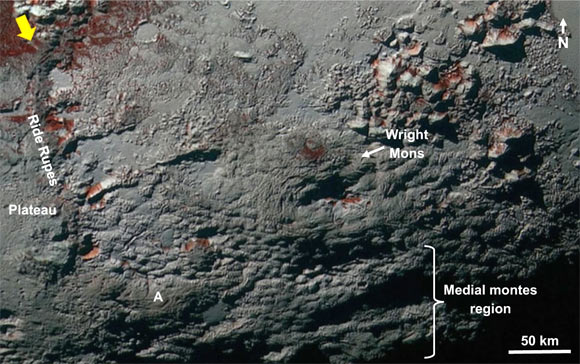Cryovolcanoes (ice volcanoes) are similar to normal volcanoes but instead of being formed from molten rock, they are made by frozen liquids like ammonia and water.

The Wright Mons region on Pluto: darker/lower albedo, redder patches exist primarily on north-facing slopes but there are also more subtle differences in albedo and redness across the region; the region labeled A represents a redder unit transition to less red units at lower elevation. The longitude and latitude extents of the image are 160-182°E and 13-31°S. Image credit: Singer et al., doi: 10.1038/s41467-022-29056-3.
“NASA’s New Horizons spacecraft returned images and compositional data showing that terrains on Pluto span a variety of ages, ranging from relatively ancient, heavily cratered areas to very young surfaces with few-to-no impact craters,” said Dr. Kelsi Singer, a researcher at Southwest Research Institute, and colleagues.
“One of the regions with very few impact craters is dominated by enormous rises with hummocky flanks.”
“Similar features do not exist anywhere else in the imaged Solar System.”
In the study, Dr. Singer and co-authors analyzed New Horizons images of an area lying to the south-west of the Sputnik Planitia ice sheet, which covers an ancient impact basin of approximately 1,000 km and is dominated by large rises with irregular flanks.
They examined the geomorphology and composition of the area and suggest it was created by cryovolcanism and the material consists mostly of water ice.
They describe many volcanic domes in the region, ranging from a few kilometers up to 7 km tall, and around 10 to 150 km across, with some domes merging to form larger structures.
“The inferred volume of a large structure known as Wright Mons is similar to the volume of Mauna Loa in Hawai’i — one of the biggest volcanoes on Earth,” they said.
The authors indicate that creation of the terrain would have required several eruption sites and a large volume of material to create the ice volcanoes.
They observed the terrain is free from impact craters, which is in contrast to some other areas of Pluto’s surface.
“The cryovolcanic activity in this area must be relatively recent in Pluto’s history and may indicate that Pluto’s internal structure has residual heat or more heat than previously anticipated, to drive such cryovolcanic activity,” they said.
Their study was published in the journal Nature Communications.
_____
K.N. Singer et al. 2022. Large-scale cryovolcanic resurfacing on Pluto. Nat Commun 13, 1542; doi: 10.1038/s41467-022-29056-3







